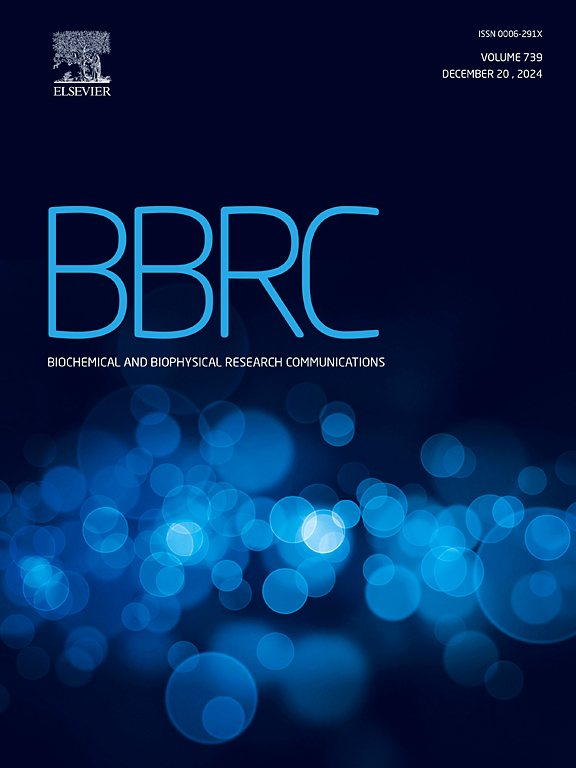IF 2.5
3区 生物学
Q3 BIOCHEMISTRY & MOLECULAR BIOLOGY
Biochemical and biophysical research communications
Pub Date : 2025-03-19
DOI:10.1016/j.bbrc.2025.151668
引用次数: 0
摘要
双酚 A(BPA)是一种合成化学物质,用于生产聚碳酸酯塑料和环氧树脂,常见于水瓶和食品容器等日常用品中。尽管双酚 A 的作用无论如何强调都不为过,但它的毒性(包括肾毒性)却是一大挑战。据报道,双酚 A 可通过调节 Nrf2/HO-1 信号传导诱导铁变态反应和淀粉样变性。另一方面,水飞蓟素可激活 Nrf2/HO-1 通路,从而提供细胞防御。然而,水飞蓟素对双酚 A 诱导的肾毒性的影响尚未见报道。本研究调查了水飞蓟素对断奶后暴露于双酚 A 的肾脏结构和功能的潜在影响。24 只雄性 Wistar 大鼠被随机分为 4 组。对照组接受药物治疗,水飞蓟素治疗组接受 100 毫克/千克/天的水飞蓟素治疗,双酚 A 治疗组接受 50 毫克/千克/天的双酚 A 治疗。双酚 A + 水飞蓟素处理组大鼠接受的处理与双酚 A 处理组和水飞蓟素处理组相同。水飞蓟素降低了双酚 A 诱导的血清尿素、肌酐、尿素氮和血浆 kim-1 水平的升高。此外,水飞蓟素还改善了双酚 A 诱导的血脂异常。此外,水飞蓟素还能抑制毒性淀粉样蛋白的形成,并改善暴露于双酚 A 的大鼠的肾组织结构。这些事件与水飞蓟素治疗抑制双酚 A 诱导的肾脏铁、MDA、TNF-α、IL-1β 和细胞色素 c 水平上升以及髓过氧化物酶和 caspase 3 活性有关。此外,水飞蓟素还能减轻双酚 A 诱导的 Nrf2 和 GSH 水平下调,以及 HO-1、GPX4、SOD、过氧化氢酶、GST 和 GR 活性下调。总之,水飞蓟素通过调控Kim-1/Nrf2/HO-1抑制铁蛋白沉积和淀粉样变性,从而减轻断奶后双酚A诱导的肾毒性。本文章由计算机程序翻译,如有差异,请以英文原文为准。
Silymarin attenuates post-weaning bisphenol A-induced renal injury by suppressing ferroptosis and amyloidosis through Kim-1/Nrf2/HO-1 signaling modulation in male Wistar rats
Bisphenol A (BPA) is a synthetic chemical used in producing polycarbonate plastics and epoxy resins and is commonly found in everyday items like water bottles and food containers. Although its usefulness cannot be overemphasized, the major challenge is its toxicity, including renal toxicity. BPA has been reported to induce ferroptosis and amyloidosis via the modulation of Nrf2/HO-1 signaling. On the other hand, silymarin activates the Nrf2/HO-1 pathway, thus providing cellular defense. However, the effect of silymarin on BPA-induced renal toxicity is yet to be reported. This study investigated the potential impact of silymarin on renal structure and function following post-weaning BPA exposure. Twenty-four male Wistar rats were randomly assigned into four equal groups. The control was vehicle-treated, while the silymarin-treated received 100 mg/kg/day of silymarin and BPA-treated rats received 50 mg/kg/day of BPA. The BPA + silymarin-treated rats received treatments as BPA-treated and silymarin-treated. Silymarin diminished BPA-induced rise in serum urea, creatinine, BUN, and plasma kim-1 levels. Also, silymarin improved BPA-induced dyslipidemia. More so, silymarin abrogated toxic amyloid formation and improved renal histoarchitecture in BPA-exposed rats. These events were associated with the suppression of BPA-induced rise in renal iron, MDA, TNF-α, IL-1β, and cytochrome c levels, and myeloperoxidase and caspase 3 activities by silymarin therapy. Furthermore, silymarin attenuated BPA-induced downregulation of Nrf2 and GSH levels, and HO-1, GPX4, SOD, catalase, GST, and GR activities. In conclusion, silymarin mitigated post-weaning BPA-induced renal toxicity by suppressing ferroptosis and amyloidosis through Kim-1/Nrf2/HO-1 modulation.
求助全文
通过发布文献求助,成功后即可免费获取论文全文。
去求助
来源期刊
CiteScore
6.10
自引率
0.00%
发文量
1400
审稿时长
14 days
期刊介绍:
Biochemical and Biophysical Research Communications is the premier international journal devoted to the very rapid dissemination of timely and significant experimental results in diverse fields of biological research. The development of the "Breakthroughs and Views" section brings the minireview format to the journal, and issues often contain collections of special interest manuscripts. BBRC is published weekly (52 issues/year).Research Areas now include: Biochemistry; biophysics; cell biology; developmental biology; immunology
; molecular biology; neurobiology; plant biology and proteomics

 求助内容:
求助内容: 应助结果提醒方式:
应助结果提醒方式:


